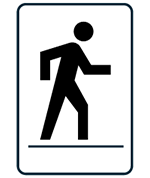[searchform]
Pedestrian Crossovers
About
Highway Traffic Act s.140 Pedestrian Crossovers
 Where a pedestrian is crossing a roadway within a crossover, drivers shall:
Where a pedestrian is crossing a roadway within a crossover, drivers shall:
- stop before the crossover
- not overtake another vehicle stopped
- wait until the pedestrian has cleared before proceeding
When approaching a crossover drivers must not pass another vehicle within 30 metres of the crossover.
What is a Crossover
Pedestrian crossovers are portions of the roadway, not at an intersection that have been indicated for pedestrians to cross the roadway.
The area maybe marked by signs, lines or other markings indicating the use for pedestrians.
What is the difference between a crosswalk and a crossover?
A crossover is a pedestrian crossing:
- not at an intersection
- where signs, markings and overhead flashing yellow lights
- indicate drivers to come to a stop.
A crosswalk is a pedestrian crossing:
- used at an intersection, and
- is the lateral extension of the sidewalk
- on each side of the road
Insurance Implications
A conviction on the drivers abstract for driving in a failing to yield at a pedestrian crossover can affect insurance rates.
Driving Records/Abstracts
Once the driver is convicted of a traffic ticket, the court sends a notice to the Ministry of Transportation.
Upon receiving the record of conviction, the Ministry of Transportation adds the court conviction to the driving record.
Driving abstracts are available to anyone who has the drivers licence number for a fee payable to the Ministry of Transportation.
Therefore the way the insurance company will finds out about the ticket is:
- insurance company contacts
- the Ministry of Transportation and
- checks the drivers abstract, or
- the driver calls and
- tells the insurance company that they received a ticket
Each insurance company is a private company with their own set of rules and standards.
Some insurance companies will not increase insurance rates for one ticket and others will. The problem is drivers don’t know what the insurance company is going to do, and if asked, there is a chance they will increase it due to the inquiry.
Drivers need to keep their driving records clear.
Demerit Points
Driving in a high occupancy lane tickets have 3 demerit points.
- G1 drivers are suspended for
- any 4 ticket with 4 demerit points
- accumulating 6 demerit points
- G2 drivers are suspended for
- any 4 ticket with 4 demerit points
- accumulating 6 demerit points
- G drivers are suspended for
- accumulating 15 demerit points
- at 8 points class G drivers may be required to attend a Demerit Point Interview
Demerit Point Interviews
If you have to attend an interview, you will get a letter (Notice of Interview) to notify you of the time, date and location of the meeting. If you do not attend your licence could be suspended.
The fee for a demerit point interview is $50 and must be paid in person at any Service Ontario Centre.
You can pay the fee when you receive the Notice of Interview or within 10 business days of attending the interview.
Failure to pay the interview fee will result in the cancellation of your driver’s licence.
Penalties
A conviction for driving in a high occupancy lane has the following penalties:
- out of court fine of $110.00
- maximum fine of $500.00
- conviction appears on driving abstract for 3 years
- can affect insurance rates
- 2 demerit points
Fines
The fine for failing to yield at a pedestrian crossover is $110.00.
Summons to Appear in Court
Where a police officer issues a summons to appear or the driver disputes the ticket, the Justice of the Peace (JP) can increase the fine up to $500.00. This rarely happens for this offence but it is possible.
The out of court fine is actually, $90.00 but the court adds a $20.00 Victim Fine Surcharge to the ticket.
What is the Victim Fine Surcharge?
- The provincial government adds a victim fine surcharge (VFS) to every non-parking fine imposed under the Provincial Offences Act.
- It is deposited into a special fund to help victims of crime.
- The amount of the VFS is usually 20 per cent of the imposed fine.
- For example, a $100 fine would result in a $20 surcharge.
- Fines over $1,000 carry a surcharge of 25 per cent.
Suspensions
Drivers are not suspended for a conviction for failing to yield at a pedestrian crossover.
Unpaid Fines
Any driver maybe suspended where any fine goes into default. Where the licence is suspended for an unpaid fine, the licence will be suspended until the payment is made to the court.
Demerit Point Suspensions
The accumulation of demerit points can result in a licence suspension.
- Class G1 and G2 drivers are suspended for accumulating 6 demerit points
- Class G1 and G2 drivers are suspended for any one ticket with 4 demerit points
- e.g. careless driving, following too close, speeding more than 30km/h
- Class G licences may receive a drivers licence interview at 8 points
- Class G licences are suspended at 15 demerits
Legal Definition
Pedestrian crossover Duties of driver
140 (1) When a pedestrian is crossing on the roadway within a pedestrian crossover, the driver of a vehicle approaching the crossover,
(a) shall stop before entering the crossover;
(b) shall not overtake another vehicle already stopped at the crossover; and
(c) shall not proceed into the crossover until the pedestrian is no longer on the roadway.
(2) Repealed: 2015, c. 14, s. 39 (1).
Passing moving vehicles within 30 metres of pedestrian crossover
(3) When a vehicle is approaching a pedestrian crossover and is within 30 metres of it, the driver of any other vehicle approaching from the rear shall not allow the front extremity of his or her vehicle to pass beyond the front extremity of the other vehicle.
Duty of pedestrian
(4) No pedestrian shall leave the curb or other place of safety at a pedestrian crossover and walk, run or move into the path of a vehicle that is so close that it is impracticable for the driver of the vehicle to comply with subsection (1).
Municipal by-laws
(5) No municipal by-law that purports to designate a pedestrian crossover on a highway on which the speed limit is in excess of 60 kilometres per hour is valid.
Riding in pedestrian crossover prohibited
(6) No person shall ride or operate a bicycle across a roadway within a pedestrian crossover.
Offence
(7) Every person who contravenes subsection (1) or (3) is guilty of an offence and on conviction is liable to a fine assessed in accordance with section 144.1.
Regulations
(8) The Minister may make regulations respecting pedestrian crossovers,
(a) providing for the erection of signs on any highway or any type or class of highway and the placing of markings on the roadway;
(b) prescribing the types of signs and markings and the location on the highway and roadway of each type of sign and marking;
(c) prohibiting the use or erection of any sign or type of sign that is not prescribed.
Definitions
“pedestrian” includes a person in a wheelchair;
“pedestrian crossover” means any portion of a roadway distinctly indicated for pedestrian crossing by signs on the highway and lines or other markings on the surface of the roadway as prescribed by the regulations
“crosswalk” means,
- that part of a highway at an intersection that is included
- within the connections of the lateral lines of the sidewalks
- on opposite sides of the highway measured from the curbs or,
- in the absence of curbs, from the edges of the roadway, or
- on opposite sides of the highway measured from the curbs or,
- within the connections of the lateral lines of the sidewalks
- any portion of a roadway at an intersection or elsewhere
- distinctly indicated for pedestrian crossing by
- signs or by lines or other markings on the surface
- distinctly indicated for pedestrian crossing by
Case Law
R. v. Kelleher, 2009 ONCJ 54 (CanLII)
2009-02-20 | 33 pages | cited by 2 documents
crossover — pedestrian — bus — offence — absolute liability
[…] TTC Bus Driver Charged Under Section 140(2) of Ontario’s Highway Traffic Act-Prosecution Alleging Driver Failed To Yield To Pedestrian In Crossover – Pedestrian Killed In Crossover Third, the defence claimed alternatively that the defendant was not obligated to stop [since the pedestrian was not properly within the crossover] and that, once the pedestrian unexpectedly entered the crossover, the defendant could not have stopped in the circumstances [had he stopped he would have risked injury to his TTC at pedestrian crossover (2) When a vehicle or street car is stopped at a pedestrian crossover, the driver of any other vehicle or street car overtaking the stopped vehicle or street car shall bring the vehicle or street car to a full stop before entering the crossover and shall yield the right of way to a pedestrian
R. v. Calleja, 2013 ONCJ 7 (CanLII)
2013-01-14 | 6 pages | cited by 2 documents
pedestrian crossover — markings — lanes — offence — roadway
[16] The Appellant argued that section 140(1)(a) specifies that a vehicle must yield the right of way to a pedestrian crossing at a pedestrian crossover. [24] The Respondent submits that the broad definition of a pedestrian crossover in the HTA subsumes the definition of a pedestrian crosswalk. [34] I find that whether the pedestrian has been hit in a crossover or a crosswalk is irrelevant to whether or not the offence of ‘Fail to Yield to Pedestrian’ has been committed.
Durham (Regional Municipality) v. Cottrell, 2013 ONCJ 638 (CanLII)
2013-10-07 | 17 pages
pedestrian crossing — markings — traffic island — channelized — crosswalk
[…] Crossovers defined 39. S. 140(1)(a) reads: Pedestrian crossover, duties of driver – subject to subsection (2) when a pedestrian or a person in a wheelchair crossing a roadway within a pedestrian crossover, […] 44. The OTM Book 15 states controlled pedestrian crossings include vehicle control by way of traffic signals, intersection pedestrian signals, mid-block pedestrian signals, pedestrian crossovers, ‘STOP’ or ‘YIELD’ or ‘SCHOOL CROSSING’ signs. […] 51. Legal pedestrian crossovers require either a ground-mounted or overhead illuminated double-sided sign indicating the presence of a pedestrian crossover to all road users to alert drivers to the presence of pedestrian crossover and to indicate to them the exact crossover location. […]


